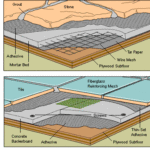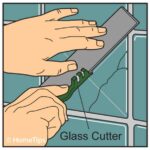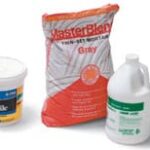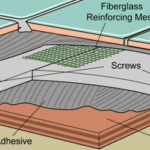This step-by-step expert guide will teach you how to install a tile membrane for flooring, a layer of material that is placed under tiles to protect the subfloor from moisture.
When it comes to flooring, particularly with ceramic or stone tiles, ensuring the longevity of your installation requires safeguarding against moisture. A tile membrane serves as a protective layer that shields the subfloor from the damaging effects of moisture infiltration.
In situations where the floor may experience flexing or where prolonged exposure to moisture is anticipated, the installation of an isolation membrane or a waterproofing membrane is recommended. These steps ensure a resilient and moisture-resistant foundation for your tile work.
Standard Method of Applying a Tile Membrane
1. Clean the area. Begin by meticulously preparing the installation area. Prior to securing a paper-backed membrane, conduct a thorough sweep and mop to eliminate even the tiniest remnants of debris. A clean starting point is essential for a successful installation.secure a paper-backed membrane, start by sweeping and mopping the floor to clear away even the smallest bits of debris.
2. Cut the membrane. Unroll the membrane and use a utility knife alongside a straightedge to cut pieces that fit the designated area. Adhere to the guidelines provided by the manufacturer regarding the required overlapping of membrane pieces.
3. Roll-up the membrane. After each piece is accurately cut, gently roll up both ends of the membrane, creating a scroll-like form. Note the sequence and orientation in which each piece will be positioned during installation.
4. Spread the adhesive on the floor. Following the adhesive paste application instructions provided by the manufacturer, distribute the adhesive evenly across the floor. Many manufacturers recommend utilizing a thick-napped paint roller for this purpose. Spread adhesive for one section of the membrane at a time, allowing the adhesive to dry until it reaches a tacky consistency.
5. Apply the membrane. The membrane features a wax-paper backing that won’t adhere to the adhesive. With the backing still intact, place a piece of the membrane onto the adhesive, unrolling both ends and ensuring precise alignment. To prevent misalignment, roll up half of the membrane while keeping the other half stationary. Carefully cut through the paper backing, initiating the process of peeling the paper away. Gradually roll out the exposed membrane onto the adhesive, with the membrane securely adhering as soon as it contacts the adhesive.
Once the initial half of the membrane is in place, use the flat edge of a trowel to smooth out any wrinkles. Repeat this procedure for the remaining half of the piece. Following these steps ensures a seamless installation.
6. Ready for tile! After installing all the membrane pieces, you can start troweling on thinset and setting tiles.
Another method of applying a membrane is simpler but more time-consuming—embedding the membrane in thinset. Spread thinset mortar—the same material that you will use to set the tiles—onto the floor using a notched trowel. Lay the pieces of membrane in the thinset, and embed them using a sheet-flooring roller. After the thinset has set, trowel on another layer of thinset in which to set the tiles.
An Alternate Approach: Embedding Membrane in Thinset
Embedding the membrane in thinset offers a simpler yet more time-intensive option sometimes preferred by professional tile installers. By following this approach, you’re integrating the membrane more securely with the thinset, thereby enhancing the overall structural integrity of your tile installation. Here’s how it works:
1. Spread thinset mortar. The first step involves distributing thinset mortar, the same material that will ultimately hold your tiles in position. Use a notched trowel to spread the thinset evenly across the floor surface.
2. Position the membrane. Lay the membrane pieces directly into the applied thinset. This process integrates the membrane seamlessly with the thinset mortar.
3. Embed with sheet-flooring roller. To ensure proper adhesion, use a sheet-flooring roller to firmly embed the membrane into the thinset. This step guarantees a secure and stable foundation for the subsequent layers.
4. Apply additional thinset layer. After the initial thinset layer has set, apply another layer of thinset over the membrane. This layer will serve as the base for setting the tiles in place.
NEXT SEE:



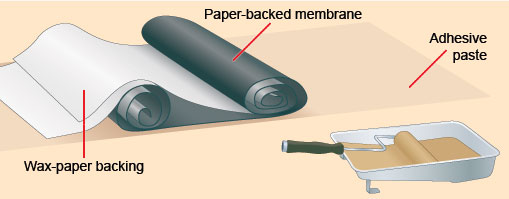
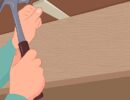


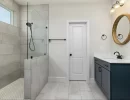
 Don Vandervort writes or edits every article at HomeTips. Don has:
Don Vandervort writes or edits every article at HomeTips. Don has:
